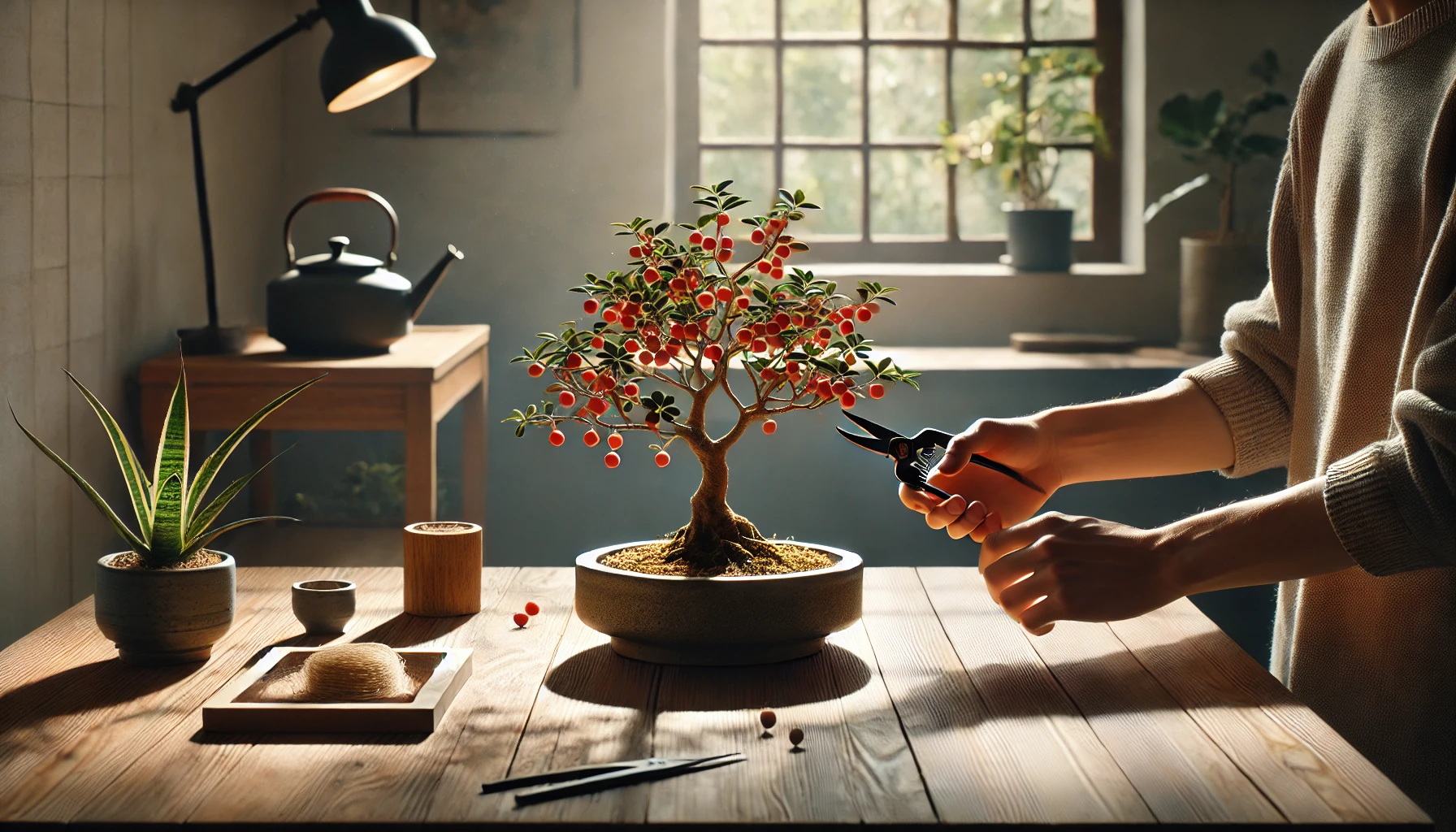Pruning is a fundamental practice in bonsai cultivation. It shapes the tree, maintains its health, and enhances its ability to produce fruits. While it may seem intimidating at first, proper pruning techniques can transform your fruiting bonsai into a miniature masterpiece. In this guide, you’ll learn how to prune your fruiting bonsai effectively and ensure it thrives.
Understanding the Importance of Pruning
Pruning is essential for several reasons:
- Maintaining Shape and Style: Pruning keeps the tree’s aesthetic form intact, adhering to traditional bonsai styles like formal upright, cascade, or informal slanting.
- Promoting Healthy Growth: Removing dead or overcrowded branches allows sunlight and air to reach all parts of the tree, reducing the risk of pests and diseases.
- Encouraging Fruiting: By focusing the tree’s energy on fewer branches, pruning stimulates flowering and fruit production.
Types of Pruning in Fruiting Bonsai
There are two main types of pruning:
- Structural Pruning: Done to establish the overall shape of the tree, often performed during the dormant season.
- Maintenance Pruning: Regular pruning to manage growth, encourage fruiting, and remove dead or damaged parts.
Tools Needed for Pruning
Using the right tools is crucial to achieve clean cuts without damaging the tree. Ensure your tools are clean and sharp to prevent infections. Here’s what you’ll need:
- Pruning shears: For cutting small to medium branches.
- Concave cutters: For precise cuts that heal smoothly.
- Scissors: For trimming leaves and fine branches.
- Wire cutters: For removing bonsai training wires.
- Disinfectant or alcohol: To sterilize tools between cuts.
Step-by-Step Guide to Pruning a Fruiting Bonsai
Step 1: Assess the Tree’s Growth
Before you start pruning, carefully observe your tree. Look for:
- Overcrowded branches blocking sunlight.
- Dead, diseased, or damaged branches.
- Growth that disrupts the tree’s intended style.
Step 2: Start with Dead or Diseased Parts
Remove all dead, broken, or diseased branches first. This not only improves the tree’s appearance but also prevents the spread of infections.
Step 3: Prune for Shape and Structure
Focus on shaping the bonsai to enhance its style.
- Identify the primary branches that define the tree’s structure.
- Remove any branches that cross, grow inward, or overshadow the primary branches.
- Use concave cutters to make precise cuts that heal cleanly and minimize scarring.
Step 4: Thin Out Foliage
For fruiting bonsai, thinning the foliage is essential to allow sunlight to reach the interior branches. This step is crucial for flower and fruit development.
- Remove excess leaves and small twigs to improve air circulation.
- Be careful not to over-thin, as this can stress the tree.
Step 5: Encourage Fruiting Growth
To promote fruit production:
- Prune back overly vigorous growth to redirect the tree’s energy.
- Leave short stems or spurs where flowers and fruits can develop.
- Focus on creating a balance between vegetative and reproductive growth.
Step 6: Use Wires for Precision Shaping
After pruning, use bonsai wires to guide the remaining branches into the desired position. This helps maintain the tree’s structure and style.
Step 7: Clean and Seal Cuts
Apply bonsai cut paste or sealant to larger cuts to prevent infections and speed up healing.
Seasonal Pruning Tips for Fruiting Bonsai
Spring
- Perform light pruning to remove weak or excess growth.
- Avoid heavy pruning during this time, as the tree is actively growing and producing flowers.
Summer
- Thin out foliage to improve air circulation and light penetration.
- Pinch back new shoots to control excessive growth.
Fall
- Focus on structural pruning as the tree enters dormancy.
- Remove any remaining weak branches that didn’t thrive during the growing season.
Winter
- This is the best time for heavy pruning, as the tree is fully dormant.
- Ensure you protect the tree from frost after pruning.
Mistakes to Avoid While Pruning
- Over-Pruning: Removing too many branches or leaves can weaken the tree and reduce fruit production.
- Ignoring Deadwood: Leaving dead branches can lead to pest infestations and diseases.
- Improper Timing: Pruning during flowering or fruiting stages can stress the tree and reduce yield.
- Unclean Tools: Using dirty tools increases the risk of infections. Always disinfect your tools before making cuts.
Post-Pruning Care for Fruiting Bonsai
After pruning, your bonsai requires extra attention to recover:
- Watering: Adjust watering as the tree may need less water due to reduced foliage.
- Fertilizing: Avoid fertilizing immediately after heavy pruning to prevent overstimulation. Wait a few weeks before resuming a balanced fertilizer schedule.
- Sunlight: Provide adequate light but protect the tree from intense sunlight until it recovers.
Benefits of Proper Pruning
- Improved Tree Health: Regular pruning removes damaged parts and promotes vigorous growth.
- Enhanced Aesthetics: A well-pruned bonsai maintains its intended style and miniature form.
- Increased Fruit Production: Proper pruning techniques channel the tree’s energy into flowering and fruiting.
With patience and practice, pruning your fruiting bonsai can become an enjoyable and rewarding part of your routine. A well-pruned bonsai tree not only looks stunning but also thrives, rewarding you with beautiful flowers and fruits year after year.

